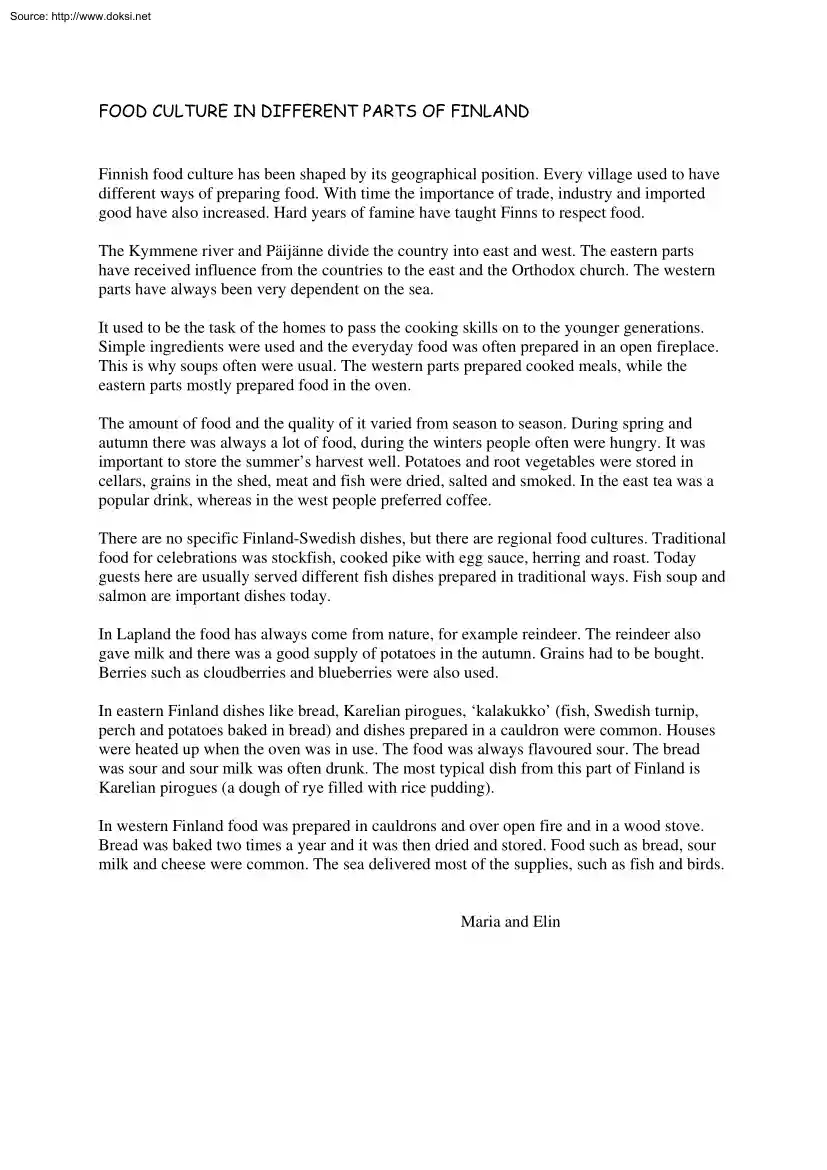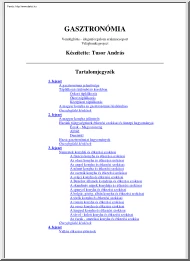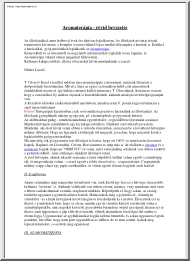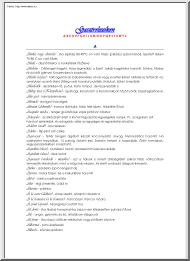Datasheet
Year, pagecount:2008, 4 page(s)
Language:English
Downloads:8
Uploaded:August 23, 2017
Size:480 KB
Institution:
-
Comments:
Attachment:-
Download in PDF:Please log in!
Comments
No comments yet. You can be the first!Most popular documents in this category
Content extract
Source: http://www.doksinet FOOD CULTURE IN DIFFERENT PARTS OF FINLAND Finnish food culture has been shaped by its geographical position. Every village used to have different ways of preparing food. With time the importance of trade, industry and imported good have also increased. Hard years of famine have taught Finns to respect food The Kymmene river and Päijänne divide the country into east and west. The eastern parts have received influence from the countries to the east and the Orthodox church. The western parts have always been very dependent on the sea. It used to be the task of the homes to pass the cooking skills on to the younger generations. Simple ingredients were used and the everyday food was often prepared in an open fireplace. This is why soups often were usual. The western parts prepared cooked meals, while the eastern parts mostly prepared food in the oven. The amount of food and the quality of it varied from season to season. During spring and autumn there was
always a lot of food, during the winters people often were hungry. It was important to store the summer’s harvest well. Potatoes and root vegetables were stored in cellars, grains in the shed, meat and fish were dried, salted and smoked. In the east tea was a popular drink, whereas in the west people preferred coffee. There are no specific Finland-Swedish dishes, but there are regional food cultures. Traditional food for celebrations was stockfish, cooked pike with egg sauce, herring and roast. Today guests here are usually served different fish dishes prepared in traditional ways. Fish soup and salmon are important dishes today. In Lapland the food has always come from nature, for example reindeer. The reindeer also gave milk and there was a good supply of potatoes in the autumn. Grains had to be bought Berries such as cloudberries and blueberries were also used. In eastern Finland dishes like bread, Karelian pirogues, ‘kalakukko’ (fish, Swedish turnip, perch and potatoes baked
in bread) and dishes prepared in a cauldron were common. Houses were heated up when the oven was in use. The food was always flavoured sour The bread was sour and sour milk was often drunk. The most typical dish from this part of Finland is Karelian pirogues (a dough of rye filled with rice pudding). In western Finland food was prepared in cauldrons and over open fire and in a wood stove. Bread was baked two times a year and it was then dried and stored. Food such as bread, sour milk and cheese were common. The sea delivered most of the supplies, such as fish and birds Maria and Elin Source: http://www.doksinet SCHOOL FOOD IN FINLAND The school food of Finland is unique in the whole world, since all the pupils in comprehensive school, vocational school and upper secondary school are served a free lunch every school day. Finnish school food is considered important for the public health, and at school pupils are encouraged to get healthy eating habits. In 1921 it became compulsory
for children aged 7 to 13 to go to school, and at the same time it was considered school food would become compulsory as well, in order to provide the children with energy for the long school days. At that time the food was only free for poor pupils, while other kids would have to pay for their food or bring their own lunch. In 1957, however, all the children were entitled to a free school lunch. Back then the food usually consisted of dishes such as soup or porridge, but in the 1960’s schools started to serve more varied food. Nowadays a Finnish school lunch consists of a warm meal and salad. Crisp bread, margarine, milk and water are also served daily. There is always special food for vegetarians and people suffering from food allergies. Here is an example of a school menu for one week: Week 8, 18-22 February 2008 Monday: Sausage, mashed potatoes, warm vegetables, salad. Tuesday: Italian stew, salad, soft bread Wednesday: Turkey sauce, rice / potatoes, salad Thursday: Salmon
pudding, beetroot, salad Friday: Porridge, jam, bread and bread topping Source: http://www.doksinet FOOD IN THE NORDIC COUNTRIES Meat is an important ingredient in our culture. Especially beef, pig, elk and deer We don’t want to lose the taste of meat so we use, for example, cream and other dairy products to reinforce the taste. Common dishes are, for example, meatballs and meatloaf Potatoes are the most usual tuber crop we eat with meat of fish. New potatoes, which are only available in summer, are very popular because they are much tastier and sweeter than potatoes later in the autumn. The most common types of fish in Scandinavia are salmon, herring and pike. A common dish in summertime is potatoes and herring. We are also fond of Janssons frestelse, or Jansson temptation, which is baked in the oven and consists of anchovies, potatoes and cream. Nowadays Scandinavian food is also influenced by Asian and other ethnic food cultures. For example, we eat a lot of rice these days
and we go to fast food restaurants. In the autumn it’s still a common pastime among the Finns to go berry-picking in the woods. It’s quite easy to find lingonberries, cloudberries and blueberries. We also like to pick mushrooms. Rye bread and ‘limpa’ are the most common types of bread in Scandinavia. Limpa can be made from many types of grain such as corn, wheat, rye etc. Limpa is usually soft and a little bit sweet. Finnish rye bread is thin and sour, but really healthy! ‘Salmiak’ is salty licorice, which has a strong taste and is only made in Finland. It’s one of Finland’s most well-know candies. Source: http://www.doksinet FINNISH FOOD ROUTINES AND HEALTH In Finland people have got access to good and healthy food, but we are bad at using this access. The lifestyle has changed a lot during the last hundred years Now we use the deepfreezer instead of using conservation and salt to keep the food in good shape We have got the opportunity to eat fresh fruit and
vegetables all through the year. Now people don’t have to work so hard for their food as they did before. Instead we spend time in front of the TV-set and the computer screen and that may be the cause why people get overweight so easily. We tend to eat too much fat, sugar and salt, and we don’t exercise enough. As a result we develop diabetes, problems with the back, neck and joints. The worst thing is that these health problems nowadays also occur amongst the young ones. The government is trying to stop this through the reduction of sugar and salt in food and forbidding the schools to sell candy and soft drinks. Salt: 5 g/day is recommended – but we eat 10 g/day the consequences of salt are high blood pressure, risk for heart diseases and kidney problems you don’t need to salt the food because it’s found in nature Sugar: we are using a lot of sugar because it tastes good and that’s the problem sugar is fast energy but it doesn’t consist of any
protection nourishment we are often replacing food with candy and other sweet things Fibre: nowadays we often replace rye with white flour wholemeal bread products consist of 5 g fibre/slice but white bread consists only of 0,8 g fibre/slice. Vegetables, root vegetables, berries and fruits also consist of fibre Fibres make it easier for the body to take in carbohydrates Our old routines are left but now we live much more comfortably, which leads to the fact that we want food that is easy to make and tastes good. This kind of food consists of too much fat, sugar and salt and not enough fibres and protection nourishment. That fact that people used to work hard for their food made the food valuable. Now it’s so easy to get food that we don’t show the same respect as we used to. Anna and Sabina
always a lot of food, during the winters people often were hungry. It was important to store the summer’s harvest well. Potatoes and root vegetables were stored in cellars, grains in the shed, meat and fish were dried, salted and smoked. In the east tea was a popular drink, whereas in the west people preferred coffee. There are no specific Finland-Swedish dishes, but there are regional food cultures. Traditional food for celebrations was stockfish, cooked pike with egg sauce, herring and roast. Today guests here are usually served different fish dishes prepared in traditional ways. Fish soup and salmon are important dishes today. In Lapland the food has always come from nature, for example reindeer. The reindeer also gave milk and there was a good supply of potatoes in the autumn. Grains had to be bought Berries such as cloudberries and blueberries were also used. In eastern Finland dishes like bread, Karelian pirogues, ‘kalakukko’ (fish, Swedish turnip, perch and potatoes baked
in bread) and dishes prepared in a cauldron were common. Houses were heated up when the oven was in use. The food was always flavoured sour The bread was sour and sour milk was often drunk. The most typical dish from this part of Finland is Karelian pirogues (a dough of rye filled with rice pudding). In western Finland food was prepared in cauldrons and over open fire and in a wood stove. Bread was baked two times a year and it was then dried and stored. Food such as bread, sour milk and cheese were common. The sea delivered most of the supplies, such as fish and birds Maria and Elin Source: http://www.doksinet SCHOOL FOOD IN FINLAND The school food of Finland is unique in the whole world, since all the pupils in comprehensive school, vocational school and upper secondary school are served a free lunch every school day. Finnish school food is considered important for the public health, and at school pupils are encouraged to get healthy eating habits. In 1921 it became compulsory
for children aged 7 to 13 to go to school, and at the same time it was considered school food would become compulsory as well, in order to provide the children with energy for the long school days. At that time the food was only free for poor pupils, while other kids would have to pay for their food or bring their own lunch. In 1957, however, all the children were entitled to a free school lunch. Back then the food usually consisted of dishes such as soup or porridge, but in the 1960’s schools started to serve more varied food. Nowadays a Finnish school lunch consists of a warm meal and salad. Crisp bread, margarine, milk and water are also served daily. There is always special food for vegetarians and people suffering from food allergies. Here is an example of a school menu for one week: Week 8, 18-22 February 2008 Monday: Sausage, mashed potatoes, warm vegetables, salad. Tuesday: Italian stew, salad, soft bread Wednesday: Turkey sauce, rice / potatoes, salad Thursday: Salmon
pudding, beetroot, salad Friday: Porridge, jam, bread and bread topping Source: http://www.doksinet FOOD IN THE NORDIC COUNTRIES Meat is an important ingredient in our culture. Especially beef, pig, elk and deer We don’t want to lose the taste of meat so we use, for example, cream and other dairy products to reinforce the taste. Common dishes are, for example, meatballs and meatloaf Potatoes are the most usual tuber crop we eat with meat of fish. New potatoes, which are only available in summer, are very popular because they are much tastier and sweeter than potatoes later in the autumn. The most common types of fish in Scandinavia are salmon, herring and pike. A common dish in summertime is potatoes and herring. We are also fond of Janssons frestelse, or Jansson temptation, which is baked in the oven and consists of anchovies, potatoes and cream. Nowadays Scandinavian food is also influenced by Asian and other ethnic food cultures. For example, we eat a lot of rice these days
and we go to fast food restaurants. In the autumn it’s still a common pastime among the Finns to go berry-picking in the woods. It’s quite easy to find lingonberries, cloudberries and blueberries. We also like to pick mushrooms. Rye bread and ‘limpa’ are the most common types of bread in Scandinavia. Limpa can be made from many types of grain such as corn, wheat, rye etc. Limpa is usually soft and a little bit sweet. Finnish rye bread is thin and sour, but really healthy! ‘Salmiak’ is salty licorice, which has a strong taste and is only made in Finland. It’s one of Finland’s most well-know candies. Source: http://www.doksinet FINNISH FOOD ROUTINES AND HEALTH In Finland people have got access to good and healthy food, but we are bad at using this access. The lifestyle has changed a lot during the last hundred years Now we use the deepfreezer instead of using conservation and salt to keep the food in good shape We have got the opportunity to eat fresh fruit and
vegetables all through the year. Now people don’t have to work so hard for their food as they did before. Instead we spend time in front of the TV-set and the computer screen and that may be the cause why people get overweight so easily. We tend to eat too much fat, sugar and salt, and we don’t exercise enough. As a result we develop diabetes, problems with the back, neck and joints. The worst thing is that these health problems nowadays also occur amongst the young ones. The government is trying to stop this through the reduction of sugar and salt in food and forbidding the schools to sell candy and soft drinks. Salt: 5 g/day is recommended – but we eat 10 g/day the consequences of salt are high blood pressure, risk for heart diseases and kidney problems you don’t need to salt the food because it’s found in nature Sugar: we are using a lot of sugar because it tastes good and that’s the problem sugar is fast energy but it doesn’t consist of any
protection nourishment we are often replacing food with candy and other sweet things Fibre: nowadays we often replace rye with white flour wholemeal bread products consist of 5 g fibre/slice but white bread consists only of 0,8 g fibre/slice. Vegetables, root vegetables, berries and fruits also consist of fibre Fibres make it easier for the body to take in carbohydrates Our old routines are left but now we live much more comfortably, which leads to the fact that we want food that is easy to make and tastes good. This kind of food consists of too much fat, sugar and salt and not enough fibres and protection nourishment. That fact that people used to work hard for their food made the food valuable. Now it’s so easy to get food that we don’t show the same respect as we used to. Anna and Sabina





 When reading, most of us just let a story wash over us, getting lost in the world of the book rather than paying attention to the individual elements of the plot or writing. However, in English class, our teachers ask us to look at the mechanics of the writing.
When reading, most of us just let a story wash over us, getting lost in the world of the book rather than paying attention to the individual elements of the plot or writing. However, in English class, our teachers ask us to look at the mechanics of the writing.